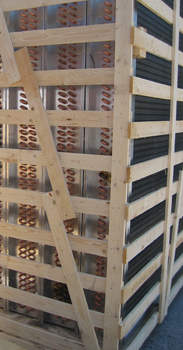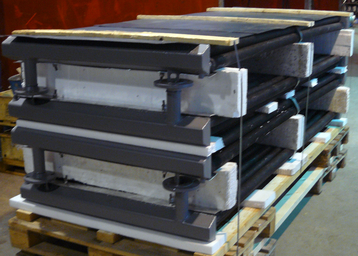
Heating coils
Heating coils are at the core of the dry kiln. They are what supplies the energy to evaporate the water. The size of the heating coils determines the temperature level we can use during the process.
A higher wet temperature level reduces energy consumption because the air can carry more water and drying times are shorter at higher temperatures. At higher wet temperatures, ventilation needs are reduced and less cold fresh air that needs to be heated when sucked into the kiln.
Another advantage of the higher wet temperature level is that the wood becomes more plastic, and this reduces cracking and deformation during drying.

We have two types of heating coils, finned flange and lamella units. The finned units are a little more expensive but more sustainable and efficient. They can be built in a way that minimises galvanic corrosion between the piping and flanges. They are a little more technical way of manufacturing units that pay for themselves thanks to a longer service life and lower air resistance through the units. This gives lower power consumption for the circulating air aggregates.
Lamella units are manufactured more industrially in large series, making them cheaper to produce, but they come with such disadvantages as smaller flange distance, which may lead to obstructed air flow, as resin and chips easily block the units. In addition, the materials used, aluminium and copper, are totally inappropriate in moist air because galvanic corrosion occurs between these metals.
Are you planning on replacing your heating coils? Then perhaps you should take the opportunity to upgrade your heating installation so that you can use higher and more modern drying temperatures.